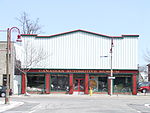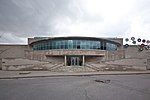Oshawa ( OSH-ə-wə, also US: -wah, -waw; 2021 population 175,383; CMA 415,311) is a city in Ontario, Canada, on the Lake Ontario shoreline. It lies in Southern Ontario, approximately 60 km (37 mi) east of Downtown Toronto. It is commonly viewed as the eastern anchor of the Greater Toronto Area and of the Golden Horseshoe. It is the largest municipality in the Regional Municipality of Durham. The name Oshawa originates from the Ojibwa term aazhawe, meaning "the crossing place" or just "a cross".Founded in 1876 as the McLaughlin Carriage Company by Robert McLaughlin, and then McLaughlin Motors Ltd by his son, Sam, General Motors of Canada's headquarters are located in the city. The automotive industry was the inspiration for Oshawa's previous mottos: "The City that Motovates Canada", and "The City in Motion". The lavish home of the automotive company's founder, Parkwood Estate, is a National Historic Site of Canada is located in the city.
Once recognized as the sole "Automotive Capital of Canada", Oshawa today is an education and health sciences hub, although General Motors still plays a significant role in the city's economy. After having been closed for about 2 years, the Oshawa car assembly plant reopened on 10 November 2021, when the first Canadian-made Chevy Silverado was completed. GM invested C$1.3bn into plant retooling. Prior to reopening, GM said that the site would continue to be used for autonomous vehicle testing and production of vehicle stampings and other sub-assemblies.The city is home to three post-secondary institutions Durham College, Trent University Durham and Ontario Tech University formerly the University of Ontario Institute of Technology as well as the Lakeridge Health Education and Research Network (LHEARN), in association with Lakeridge Health Oshawa, formerly the Oshawa General Hospital. Key labour force sectors include advanced manufacturing, health technology, logistics, energy and IT. In 2016, Oshawa was the sixth best place in Canada to find full-time employment based on data from StatsCan.Downtown Oshawa is identified as an Urban Growth Centre in the Government of Ontario's Places to Grow initiative. More than 5,000 people work and more than 2,400 university students study in the downtown core. The downtown is a prominent centre for entertainment and sporting events (Regent Theatre and Tribute Communities Centre), food (50+ restaurants and cafes) and culture (The Robert McLaughlin Gallery and Canadian Automotive Museum). Oshawa is home to a Regional Innovation Centre and offers start-up facilities for entrepreneurs and small businesses. Co-working offices are also located in the downtown.






